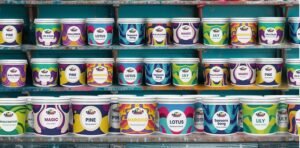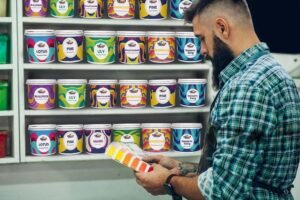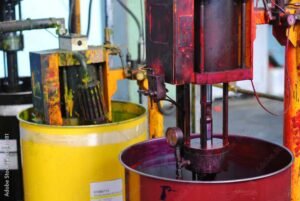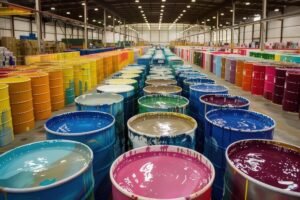Introduction to Analysis of Paint Manufacturing Costs
The paint manufacturing process is a complex sequence of operations that transforms raw materials into the finished products that consumers and industries use. This process begins with the sourcing of raw materials, which are critical for producing various types of paints, including the traditional mithila paints known for their rich cultural significance and intricate artistry. Raw materials used in paint manufacturing typically include pigments, resins, solvents, and additives, each playing a vital role in determining the paint’s color, texture, and durability.
Once the raw materials are procured, the manufacturing process involves several key stages: formulation, mixing, grinding, and filling. During the formulation stage, manufacturers create specific recipes that achieve the desired paint characteristics. This includes choosing appropriate pigments and resins that will result in the color and performance attributes sought after in the final product. The mixing phase involves combining these ingredients in precise ratios to ensure uniform consistency and quality.
Following mixing, the grinding stage is crucial, as it disperses the pigments evenly throughout the mixture, resulting in a smooth and stable paint. Techniques may vary based on the desired end product, with some manufacturers focusing on specialized paint types such as mithila paints, which often utilize unique traditional methods and local materials for their production. The final filling stage entails packaging the paint into containers for distribution. Attention to detail during this process is essential for maintaining quality and preventing contamination.
Understanding the manufacturing costs associated with each stage is vital for paint manufacturers, as it directly influences pricing strategies and profitability. A detailed analysis of these cost components will provide insights into the challenges faced by the industry and the economic implications for producers. Recognizing manufacturing costs also aids companies in making informed decisions about sourcing, production methods, and market positioning within the competitive landscape of the paint industry.

Key Raw Materials Used in Paint Manufacturing
In the realm of paint manufacturing, the quality and cost of the final product are largely determined by the key raw materials utilized in the formulation process. Among the most critical components are pigments, binders, solvents, and additives, each playing a unique role in producing paints that meet diverse aesthetic and functional requirements.
Firstly, pigments are the granular substances that impart color to paint formulations. They are available in two categories: organic and inorganic pigments. Organic pigments are generally known for their vibrant shades but may come with higher price tags and stability issues. In contrast, inorganic pigments, such as titanium dioxide, offer excellent durability and opacity at a more economical cost. The choice of pigments significantly influences both the visual appeal and the cost-effectiveness of paint products, including traditional mithila paints.
Next are binders, which serve as the glue that holds pigment particles together and adheres them to surfaces. Common types of binders include acrylics, polyurethanes, and alkyds. Each type has distinct properties affecting the paint’s durability, drying time, and resistance to environmental conditions. Higher-quality binders contribute to an increased manufacturing cost but result in superior performance and longevity of the paint, which is essential for products designed for long-lasting applications.
Solvents play a vital role in paint formulation by providing the necessary viscosity and facilitating the application process. They evaporate as the paint dries, leaving the binder and pigments to form a durable film. The selection of solvents impacts environmental compliance and the overall cost structure, making it crucial for manufacturers to balance performance and regulatory requirements.
Lastly, additives are included in small amounts to enhance specific properties of the paint such as flow, drying time, and antimicrobial resistance. Although these materials represent a minor fraction of the total formulation, they can influence both performance and production expenses significantly. Understanding the interplay of these raw materials is essential for optimizing costs in the competitive landscape of paint manufacturing.

Labor Costs in Paint Production
Labor costs constitute a significant portion of the total expenses in paint manufacturing, playing a crucial role in determining the overall cost-effectiveness of production. These costs typically encompass wages, benefits, and necessary training expenses for employees involved in the production process. When analyzing labor costs, it is important to consider not only the direct compensation paid to workers but also indirect expenses that contribute to the total workforce cost.
Wages represent a primary factor influencing overall labor costs. The amount paid to workers can vary significantly based on geographic location, skill level, and experience. Additionally, benefits such as health insurance, retirement plans, and paid time off further contribute to the financial burden of maintaining a skilled workforce. Consequently, paint manufacturing companies must implement effective budgeting strategies to manage these labor costs while remaining competitive in the market.
Training expenses are another important aspect of labor costs. Investing in employee training ensures a higher level of productivity, which can ultimately lead to reduced per-unit costs in paint production. By equipping workers with the skills necessary to operate machinery efficiently and adhere to quality standards, companies can enhance productivity and minimize errors, further optimizing their operational expenses.
Moreover, a focus on labor productivity can have a significant impact on the overall costs associated with paint manufacturing. Higher productivity means that workers can produce more paint in a shorter period, thereby reducing the labor cost per unit of product. This can be achieved through various strategies, including automating certain processes, implementing lean manufacturing principles, and fostering a positive work environment that encourages employee engagement and efficiency. Overall, by closely monitoring and optimizing labor costs, paint manufacturers can bolster their bottom line while maintaining quality standards essential to products like mithila paints.

Overhead and Utilities in Paint Manufacturing
Overhead and utility costs represent substantial components of the overall expense structure in paint manufacturing, including the creation of products like mithila paints. These costs can vary significantly based on several factors, including location, scale of production, and efficiency of operations. One of the most prominent overhead costs is factory rent, which is determined by factors such as geographical location and facility size. For instance, manufacturing sites located in industrial hubs may incur higher rent but may benefit from proximity to suppliers and a skilled workforce. Conversely, facilities situated in less urban areas may enjoy lower rent but might face logistical challenges.
Another crucial aspect of overhead costs in paint manufacturing is insurance. This coverage is essential to protect the business against potential liabilities, including property damage and employee safety incidents. The premiums paid for such insurance will vary depending on the size of the operation, the range of products produced, and the risk assessment conducted by insurance providers. Regular maintenance is equally important, ensuring that the machinery and equipment used in the production of mithila paints are kept in optimal working condition, thus preventing costly downtimes and further expenses.
Utility costs also play a significant role in paint manufacturing. Electricity is vital for operating machinery, lighting, and climate control within the facility. Water, too, is indispensable, especially in processes related to mixing ingredients and cleaning operations. The efficiency of energy use can directly impact production costs, making it essential for manufacturers to seek out energy-efficient technologies and practices. Furthermore, fluctuations in utility rates can add an unpredictable element to cost planning. In addressing these factors, businesses engaged in the production of mithila paints must scrutinize their overhead and utility expenditures to optimize profitability while maintaining product quality.

Research and Development Expenses
The landscape of paint manufacturing is significantly influenced by research and development (R&D) expenses. As the paint industry continues to evolve with new consumer demands and technological advancements, the importance of innovation cannot be overstated. R&D plays a crucial role in the formulation of new products, including mithila paints, that not only meet user requirements but also comply with environmental regulations. This process often begins with ideation, where new concepts are generated and assessed for viability. It progresses to formulation and testing, both of which entail substantial costs.
Personnel costs represent a significant portion of R&D expenses in paint manufacturing. Skilled scientists and researchers are employed to experiment with different formulations and materials. These professionals are essential for creating innovative products like mithila paints that deliver high performance while promoting sustainability. Additionally, ongoing training and skill development for these individuals ensure they remain updated with the latest trends and technologies. Therefore, investing in human capital is indispensable to fostering innovation.
Material costs also contribute heavily to R&D spending. The exploration for new pigments, binders, and additives is paramount in developing paints that offer enhanced durability, color accuracy, and application properties. Each new component requires thorough examination to ascertain its suitability, which can involve significant trial and error. Moreover, the costs of laboratory materials and equipment necessary for rigorous testing procedures can accumulate rapidly. This investment is vital to ensure that new products like mithila paints not only perform well but are also safe for consumers and the environment.
Testing expenses, including the evaluation of product performance under various conditions, must also be factored into R&D budgets. These costs are essential for quality assurance and regulatory compliance. In summary, the role of research and development in paint manufacturing, particularly for innovating products such as mithila paints, is indispensable and requires a substantial financial commitment in personnel, materials, and testing processes.
Quality Control and Regulatory Compliance Costs
In the paint manufacturing industry, maintaining high standards of quality control and adhering to regulatory compliance is paramount. The costs associated with these processes are significant but necessary to ensure the integrity of the products and the safety of consumers. Quality control encompasses various activities, including the testing of raw materials, production processes, and finished products. Each of these stages involves expenditures related to equipment, personnel, and testing procedures, which can accumulate rapidly. For manufacturers of mithila paints, these costs are particularly important due to the specialized nature of the product, which requires strict adherence to quality standards.
Moreover, regulatory compliance adds another layer of complexity and expense. Paint manufacturing is subject to numerous regulations, including environmental laws, safety standards, and health regulations. Compliance necessitates ongoing training for staff, regular audits, and sometimes investment in upgraded technologies or systems to monitor emissions and chemical usage. Failure to meet these regulatory requirements can result in substantial fines and damage to a company’s reputation. Therefore, the financial implications of non-compliance can extend far beyond immediate costs, influencing the long-term sustainability of the business.

The significance of maintaining these standards cannot be overstated. High-quality products enhance customer satisfaction, foster brand loyalty, and ultimately contribute to increased sales. For instance, mithila paints, known for their vibrant colors and cultural relevance, must be manufactured under stringent quality control to ensure that they meet consumers’ expectations. Investing in quality assurance and regulatory compliance not only mitigates risks but also serves as a competitive advantage in the market. Consequently, the costs associated with these processes should be viewed as vital investments rather than mere expenses.
Distribution and Marketing Expenses
The distribution and marketing of paint products involve a series of expenses that significantly influence the overall manufacturing costs and profit margins. In the context of mithila paints, which exemplifies quality and craftsmanship, understanding these expenses is crucial for stakeholders involved in the paint manufacturing sector.
Logistics plays a key role in the distribution process. It encompasses the transportation of finished products from manufacturing facilities to retailers or directly to consumers. Businesses must account for shipping costs, which can fluctuate based on distance, fuel prices, and freight methods. Additionally, employing a reliable logistics service can incur higher costs but may be necessary to maintain product quality during transit. For mithila paints, ensuring timely delivery is essential to preserve customer satisfaction and loyalty, reinforcing the need for effective logistics management.
Another significant factor in distribution is packaging. The packaging of paint products not only serves an aesthetic purpose but also protects the integrity of the product. High-quality packaging materials can increase production costs, yet they are essential for preventing leaks, spills, or product degradation during storage and transport. When it comes to mithila paints, creating visually appealing and durable packaging can also enhance brand recognition and appeal to buyers, thus justifying the added expense.
Furthermore, marketing strategies employed to promote paint products can add another layer of costs. Advertisements, promotional campaigns, and sponsorships are integral to gaining market share and increasing sales. For mithila paints, effective marketing can create a strong brand image and enable the company to differentiate itself from competitors in a crowded marketplace. Implementing diverse strategies, such as digital marketing and community engagement, requires careful budgeting to ensure a positive return on investment.
In conclusion, the expenses associated with distribution and marketing are paramount in shaping the financial outcomes of paint manufacturing. By understanding and managing these costs, companies such as mithila paints can optimize their operations and enhance profitability while maintaining product integrity and customer satisfaction.
Cost-Reduction Strategies for Paint Manufacturers
Cost control is a significant challenge for paint manufacturers, particularly in the context of rising raw material prices and competitive market dynamics. One effective strategy involves optimizing supply chain management. Implementing advanced forecasting techniques can enable manufacturers to anticipate demand more accurately. By aligning inventory levels with market needs, companies can minimize carrying costs and reduce waste associated with excess stock. Establishing strong relationships with suppliers offers the added benefit of negotiating better prices and leveraging bulk purchasing advantages, thereby lowering overall procurement costs.
Investing in efficient technology is another crucial strategy for reducing production costs in the paints sector. Automated mixing and dispensing systems, for instance, can lead to significant savings in both time and labor. These automated processes not only improve precision but also enhance consistency in the final product, which is essential for maintaining high quality in mithila paints and other formulations. Moreover, utilizing energy-efficient machinery can substantially decrease utility costs and contribute to sustainability goals, further appealing to environmentally conscious consumers.
Improving production processes is equally vital for cost reduction. Continuous monitoring and assessment of operational workflows can identify bottlenecks and inefficiencies. Implementing lean manufacturing principles can help streamline operations, minimize waste, and optimize resource use. Additionally, investing in staff training ensures that employees are skilled in using new technologies and adhering to best practices, thus bolstering productivity. By encouraging a culture of innovation and efficiency, paint manufacturers can create an agile production environment capable of adapting to fluctuating market demands.
By integrating these cost-reduction strategies, paint manufacturers can enhance their competitive edge while ensuring the quality and affordability of their products, including various mithila paints. Each approach contributes to a holistic strategy for long-term financial stability in the ever-evolving paint industry.

Conclusion and Future Trends in Paint Manufacturing Costs
In analyzing the costs associated with paint manufacturing, it is essential to recognize the multifaceted influences that shape these expenses. Factors including raw material prices, labor costs, and technological advancements play a significant role in determining the overall cost structure. As the market evolves, new trends are emerging that could further impact paint manufacturing, particularly with respect to products like mithila paints, which embody cultural richness and artistic expression.
One prominent future trend is the increasing of sustainable practices within the industry. With growing environmental consciousness among consumers, manufacturers are under pressure to adopt eco-friendly processes and materials. This shift not only involves sourcing sustainable raw materials but also optimizing production methods to minimize waste and reduce carbon footprints. Mithila paints, known for their intricate designs and traditional techniques, may need to align with these sustainability trends to maintain market competitiveness and meet evolving consumer expectations.
Emerging technologies also play a crucial role in shaping future manufacturing costs. Automation and artificial intelligence can lead to greater efficiency and accuracy in production, resulting in reduced labor costs and material wastage. Furthermore, digitalization allows for real-time data monitoring, providing manufacturers with insights that facilitate cost-effective decision-making. The integration of such technologies could become a significant driver of change within the paint industry, including the production of mithila paints, potentially lowering overall manufacturing costs.
Lastly, consumer demands are constantly shifting toward more personalized and high-quality products. As consumers seek unique and customized options, paint manufacturers must adapt to these preferences, which may further influence cost structures. The trend toward artisanal and handcrafted products like mithila paints could see increased production costs, yet they may also yield higher market prices, balancing the overall economic impact.


